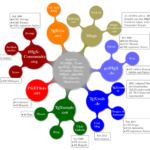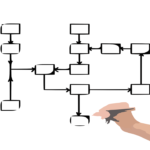Description: Word Webs are a collaborative approach to concept mapping. A central idea is added to a shared writing space. In small groups, students then generate a list of related ideas and organize them around the central idea in which they can visually represent how the ideas connect. This technique helps students to analyze challenging […]
Sequence Chains
Description: In this activity groups of students “analyze and depict graphically a sequence of events, actions, roles, or decisions. Sequence chains require students to create a visual map of the logic within a series” (Barkley, et al, 2014, p. 278). Students have to work together to identify the key events or points in the series […]
Dialogue Journals
Description: In this activity, students keep a journal to capture their thinking about course readings, assignments, lectures, and class activities. They then exchange their journal with a peer to create an ongoing dialogue of questions, answers, insights and ideas. The students can develop their journal in a digital or analog format. The instructor can prompt […]
Note-Taking Pairs
Description: In this activity student partners work together to improve their note-taking skills. Over time, each student improves her individual note-taking skills. By working in pairs, students can compare notes on a class lecture, reading or other activity. They help each other to fill in the gaps in their notes, correct inaccuracies, and add detail […]
Learning Teams
Description: For this type of group, students are divided into groups at the beginning of the term. When you want to incorporate small group discussion or teamwork into your class, you direct the students to get into these term-long learning groups. Groups of four work well, because each foursome can be subdivided into pairs, depending […]
Fishbowl
Description: This method involves one group observing another group. The first group forms a circle and either discusses an issue or topic, does a role play, or performs a brief drama. The second group forms a circle around the inner group. Depending on the inner group’s task and the context of your course, the outer […]
Snowball Groups/Pyramids
Description: This method involves progressive doubling: students first work alone, then in pairs, then in fours, and so on. In most cases, after working in fours, students come together for a plenary session in which their conclusions or solutions are pooled. Provide a sequence of increasingly complex tasks so that students do not become bored […]
Rotating Trios
Description: This strategy involves students discussing issues with many of their fellow classmates in turn. Beforehand, prepare discussion questions. In class, students form trios, with the groups arranged in a large circle or square formation. Give the students a question and suggest that each person take a turn answering. After a suitable time period, ask […]
Circle of Voices
Description: This method involves students taking turns to speak. Students form circles of four or five. Give students a topic, and allow them a few minutes to organize their thoughts about it. Then the discussion begins, with each student having up to three minutes (or choose a different length) of uninterrupted time to speak. During […]







